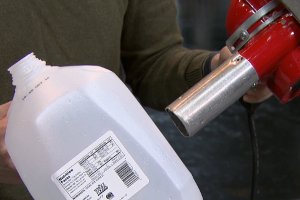
I have a plastic bottle on my desk. It once contained the cola beverage I really should stop drinking. I go through at least one of these each day, a habit cut down from a former 6-pack-a-day deluge. I know the cola isn’t good for me, but now I’m thinking the plastic bottle is even worse.
I have something else on my desk: a pamphlet compiled by Peter Bryant of UC Irvine titled, “What’s Wrong with Plastic Water Bottles?” Did you know that each year, “144 BILLION beverage containers end up in U.S. landfills, roads, streams and parks?” Laid end-to-end, according to Bryant, those containers would “encircle the Earth 720 times, or reach to the Moon and back 38 times.” In the United States, only 10 to 12% of plastic bottles are recycled. That waste is truly astronomical. And keep in mind that it takes at least 1000 years for those plastic bottles to break down in the landfill.
Most plastic bottles are made of polyethylene terephthalate, or PET. That’s a petroleum product. “4% of the world’s oil production is used as “feedstock” for plastic,” according to Bryant, “and another 4% provides the energy to transform it into plastic.” And of course then there’s the fuel needed to transport it to market. San Francisco has some of the cleanest, freshest water in the world coming out of the taps. Yet it wouldn’t take you long to find someone walking down the street with a bottle of water that came from France or Fiji at 1000 times the price of the water coming from the kitchen faucet. Why?
